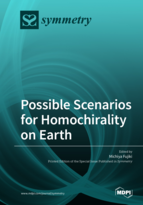Possible Scenarios for Homochirality on Earth
A special issue of Symmetry (ISSN 2073-8994). This special issue belongs to the section "Chemistry: Symmetry/Asymmetry".
Deadline for manuscript submissions: closed (31 July 2019) | Viewed by 64614
Special Issue Editor
Interests: symmetry breaking; polarized light; helix; photoexcited state; weak neutral current; Hund’s paradox
Special Issue Information
Dear Colleagues,
As evidenced in several Myths, humankind has long been thinking of life: Where did our life come from? And where will our life go? A more apt question is whether life exists only on Earth. In 1903, Svante Arrhenius proposed the radio-panspermia hypothesis as the origin of life; that is, certain seeds of life in the size of 200–300 nm travelled slowly by solar radiation pressure and landed on the Earth. This scenario led to the litho-panspermia and ballistic panspermia hypotheses. In 1978, Fred Hoyle proposed that interstellar comets carrying several viruses landed on the Earth to ensure these panspermia hypotheses. With respect to our life, the origin of homochirality on the Earth has been the greatest mystery because our life cannot exist without molecular asymmetry. Living organisms on the Earth are always tempo-spatial and metastable as a consequence of a far-from-equilibrium open system. Life can survive only under open flows of energy and chemical sources because life eats low-entropy foods and/or harvests solar/thermal energy.
In recent years, several discoveries led by modern spacecrafts and telescopes have brought new horizons on the origins of life and chirality. For example, Hubble space telescope (NASA) captured geysers of liquid water from Europa, one of Jupiter’s moons. Rosetta (ESA) detected prebiotic constituents and water on the comet, 67P/Churyumov-Gerasimenko, that is one of the Jupiter family. Using a quadrupole gravity measurement system, Cassini (NASA) discovered water under the surface of Enkelados, one of Saturn’s moons. The Jet Propulsion Laboratory (NASA) showed that Titan, the largest Saturnian moon, has water comprising inorganic salts. Kepler (NASA) discovered over two thousand Earth-like exoplanets, located in habitable zones. More recently, in 2016, radio telescope astronomers detected chiral propylene oxide in a giant molecular cloud, called SagittariusB2 in the Milky Way Galaxy, by analyzing absorption bands in mm wavelength, although the L-D preference is yet to be characterized.
Thus far, many scientists have proposed several possible hypotheses to answer this long-standing L-D question. Previously, Martin Gardner raised the question about mirror symmetry and broken mirror symmetry in terms of the homochirality question in his monographs (1964 and 1990). Possible scenarios for the L-D issue can be categorized into (i) Earth and exoterrestrial origins, (ii) by-chance and necessity mechanisms, and (iii) mirror-symmetrical and non-mirror-symmetrical forces as physical and chemical origins. These scenarios should involve further great amplification mechanisms, enabling pure L- or D-world. Recent studies have demonstrated that even nearly racemic substances as low as 10–5 % ee can be significantly amplified to nearly 100 % ee.
The present Special Issue encourages researchers from a broad range of disciplines to publish original papers, account papers, and reviews, which describe possible scenarios of bimolecular handedness, followed by the L-D amplification on the Earth, and also a possible life under the exoterrestrial cosmological environments.
Prof. Michiya Fujiki
Guest Editor
Manuscript Submission Information
Manuscripts should be submitted online at www.mdpi.com by registering and logging in to this website. Once you are registered, click here to go to the submission form. Manuscripts can be submitted until the deadline. All submissions that pass pre-check are peer-reviewed. Accepted papers will be published continuously in the journal (as soon as accepted) and will be listed together on the special issue website. Research articles, review articles as well as short communications are invited. For planned papers, a title and short abstract (about 100 words) can be sent to the Editorial Office for announcement on this website.
Submitted manuscripts should not have been published previously, nor be under consideration for publication elsewhere (except conference proceedings papers). All manuscripts are thoroughly refereed through a single-blind peer-review process. A guide for authors and other relevant information for submission of manuscripts is available on the Instructions for Authors page. Symmetry is an international peer-reviewed open access monthly journal published by MDPI.
Please visit the Instructions for Authors page before submitting a manuscript. The Article Processing Charge (APC) for publication in this open access journal is 2400 CHF (Swiss Francs). Submitted papers should be well formatted and use good English. Authors may use MDPI's English editing service prior to publication or during author revisions.
Keywords
- symmetry breaking
- polarized light
- helix
- photoexcited state
- weak neutral current
- Hund’s paradox






